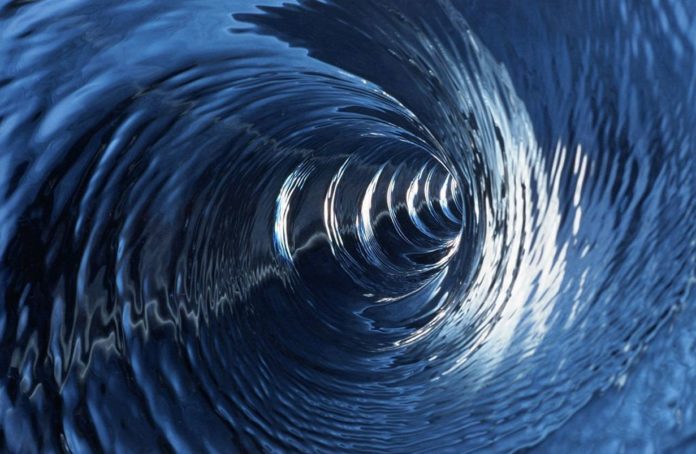This fluid-like electron behavior, which has long been predicted but never been seen, could be used to create low-power next-generation devices.
Although water molecules are separate particles, they flow collectively as liquids, generating streams, waves, and other traditional fluid phenomena.
This is not the case with electrical current. Even though an electric current is made up of discrete particles, in this case, electrons, any collective behavior among the particles is masked by stronger influences when the electrons move through common metals.
However, in some materials and under particular circumstances, these effects disappear, allowing electrons to interact directly with one another. Electrons can move as a group in these situations, much like a fluid.
Now, physicists from MIT and the Weizmann Institute of Science have discovered electrons flowing in vortices, or whirlpools – a characteristic of fluid flow that theorists had predicted electrons should show, but which had never been observed before.
According to MIT physics professor Leonid Levitov, “Electron vortices are expected in theory, but there’s been no direct proof, and seeing is believing.” Now they have observed it, “it’s a clear signature of being in this new regime, where electrons behave as a fluid, not as individual particles”.
The findings, which were published in the journal Nature, may help designers create electronics that are more effective.
Levitov says, “we know when electrons go in a fluid state, [energy] dissipation drops, and that’s of interest in trying to design low-power electronics.” This new finding is a step in the right direction.
Levitov, Eli Zeldov, and others from the Weizmann Institute for Science in Israel and the University of Colorado at Denver wrote the new paper together.
A collective squeezing
When electricity flows through most metals and semiconductors, impurities in the material and vibrations between the atoms of the material affect the momentum and paths of the electrons in the current. In common materials, these mechanisms dominate electron behavior.
However, theorists have anticipated that quantum effects should take control in the absence of such common, classical processes. In particular, electrons should travel as a viscous, honey-like electron fluid in concert as a result of picking up on each other’s delicate quantum behavior. This liquid-like behavior ought to manifest in ultrapure materials and at temperatures close to absolute zero.
The University of Manchester’s Levitov and colleagues presented evidence of this fluid-like electron behavior in graphene in 2017. They had etched a tiny channel with many pinch points into this atom-thin carbon sheet to create graphene.
They discovered that the constrictions presented little resistance to a current delivered through the channel.
This demonstrated that rather than clogging like individual sand grains, the electrons in the current were able to pass past the pinch points collectively, like a fluid.
Levitov began investigating further electron fluid phenomena after this initial indication. He and colleagues at the Weizmann Institute for Science sought to see electron vortices in the new study.
They state in their research that despite multiple theoretical predictions, “the most striking and ubiquitous feature in the flow of regular fluids, the formation of vortices and turbulence, has not yet been observed in electron fluids despite numerous theoretical predictions.”
Directing flow
The scientists used tungsten ditelluride (WTe2), an ultraclean metallic compound that has been discovered to exhibit exotic electrical properties when isolated in single-atom thin, two-dimensional form, to see electron vortices.
According to Levitov, tungsten ditelluride is one of the new quantum materials where electrons interact intensely and behave more like quantum waves than particles. Additionally, the material is exceptionally clean, which directly exposes the fluid-like motion.
They created tungsten ditelluride as pure single crystals and exfoliated it into tiny flakes. Then, they patterned each flake into a center channel connecting to a circular chamber on either side using e-beam lithography and plasma etching techniques.
They etched the identical design into tiny gold flakes, a common metal with conventional electrical characteristics.
They then applied a current to each patterned sample at 4.5 kelvins, or roughly -450 degrees Fahrenheit, and used a nanoscale scanning superconducting quantum interference device (SQUID) on a tip to measure the current flow at particular locations across each sample.
This instrument, which was created in Zeldov’s lab, measures magnetic fields with incredibly fine accuracy. By scanning each sample with the device, the team could see in detail how electrons moved through the channels in each material.
Even though a portion of the current went through each side chamber before rejoining the main current, the researchers noticed that electrons travelling via designed channels in gold flakes did not reverse direction.
In contrast, electrons moving through tungsten ditelluride moved through the channel and swirled into each side chamber, like water would do when it empties into a bowl. Before going back into the main channel, the electrons made small whirlpools in each chamber.
Levitov adds, that they saw “a change in the flow direction in the chambers, where the flow direction reversed the direction as compared to that in the central strip.”
It follows the same physics as what happens in regular fluids, but with electrons operating at a nanoscale. That is a definite indicator that electrons are operating in a fluid-like environment.
The findings provide the first direct viewing of swirling vortices in an electric current. The findings constitute experimental confirmation of a fundamental electron behavior feature. They might also provide hints for how engineers could create low-power gadgets with less resistive, more fluid electrical conductivity.
Image Credit: Getty
You were reading: For The First Time, Physicists Witness Electron Whirlpools
